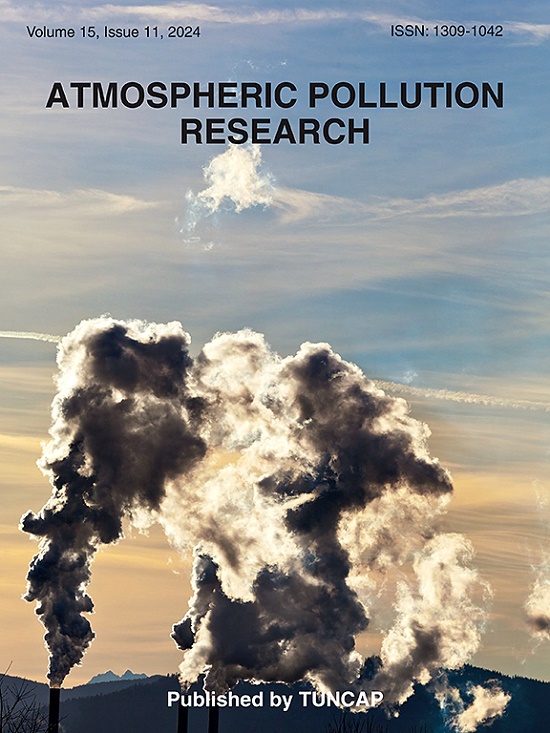Biomonitoring of airborne magnetic particles over time: an in situ magnetic susceptibility-based methodology
IF 3.5
3区 环境科学与生态学
Q2 ENVIRONMENTAL SCIENCES
引用次数: 0
Abstract
We introduce a novel methodology that utilizes in situ magnetic susceptibility (κis) measurements through transplants of Tillandsia capillaris, which facilitates the quantification of (sub)micron-sized magnetite particles that may pose health risks. Scanning Electron Microscopy with Energy Dispersive Spectroscopy analysis reveals the presence of iron-rich spherical, semi-spherical, and irregular particles, along with potentially toxic elements such as chromium, cobalt, and manganese. Over one year, we tested two in situ measuring protocols—direct-contact methodology (DCM) and Petri-wood methodology (PWM)—on thirty-nine samples. The κis values obtained were comparable; however, the DCM exhibited a higher coefficient of variation (CV ≈ 1–97 %) compared to the PWM (CV ≈ 0–10 %). The PWM demonstrated low dispersion in its results, with a standard error of the mean of 0–3 × 10−7 SI, which is comparable to the instrument's sensitivity of 1 × 10−7 SI. The maximum change in κis observed in the transplants during the year of exposure across various sites ranged from 2.8 to 13.1 × 10−6 SI, indicating an accumulation of airborne magnetic particles (AMP) between 0.13 and 0.63 mg on the transplants. The analysis over one year suggests that traffic avenues corresponded with high AMP accumulation, while most other sites exhibited moderate accumulation. This insight is crucial for developing more accurate in situ measurement protocols and for understanding the role of epiphytic plants as biomonitors of air particle pollution.

空气中磁性粒子的生物监测:一种基于原位磁化率的方法
我们介绍了一种新的方法,利用原位磁化率(κis)测量通过移植的Tillandsia capillaris,这有助于量化(亚)微米大小的磁铁矿颗粒,可能会造成健康风险。扫描电子显微镜和能量色散光谱分析揭示了富含铁的球形、半球形和不规则颗粒的存在,以及潜在的有毒元素,如铬、钴和锰。在一年多的时间里,我们在39个样品上测试了两种原位测量方案-直接接触法(DCM)和Petri-wood法(PWM)。获得的κis值具有可比性;然而,与PWM (CV≈0 - 10%)相比,DCM表现出更高的变异系数(CV≈1 - 97%)。结果表明,PWM的色散较低,平均标准误差为0-3 × 10 - 7 SI,与仪器的灵敏度1 × 10 - 7 SI相当。在暴露的一年中,移植体中κ的最大变化在2.8至13.1 × 10 - 6 SI之间,表明空气中磁性颗粒(AMP)在移植体上的积累在0.13至0.63 mg之间。一年多的分析表明,流量途径对应于高AMP积累,而大多数其他站点显示中等积累。这一见解对于制定更准确的原位测量方案和理解附生植物作为空气颗粒污染生物监测仪的作用至关重要。
本文章由计算机程序翻译,如有差异,请以英文原文为准。
求助全文
约1分钟内获得全文
求助全文
来源期刊

Atmospheric Pollution Research
ENVIRONMENTAL SCIENCES-
CiteScore
8.30
自引率
6.70%
发文量
256
审稿时长
36 days
期刊介绍:
Atmospheric Pollution Research (APR) is an international journal designed for the publication of articles on air pollution. Papers should present novel experimental results, theory and modeling of air pollution on local, regional, or global scales. Areas covered are research on inorganic, organic, and persistent organic air pollutants, air quality monitoring, air quality management, atmospheric dispersion and transport, air-surface (soil, water, and vegetation) exchange of pollutants, dry and wet deposition, indoor air quality, exposure assessment, health effects, satellite measurements, natural emissions, atmospheric chemistry, greenhouse gases, and effects on climate change.
 求助内容:
求助内容: 应助结果提醒方式:
应助结果提醒方式:


